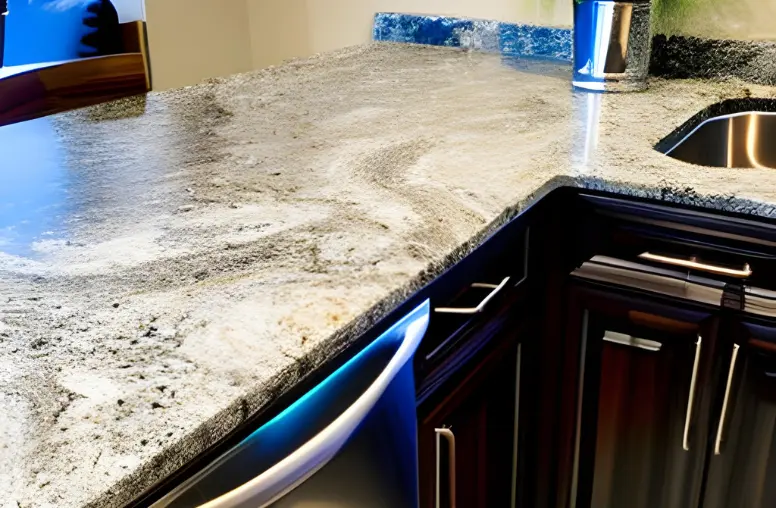Ever wondered why that beautiful, gleaming granite countertop in your kitchen suddenly shows up with an unpleasant yellow stain? The answer lies in the various day-to-day activities you carry out on it.
To put it simply, the regular use of your granite countertop is bound to leave some mark or stain, especially if you aren’t vigilant about its maintenance. And this brings us to an essential question – how can you remove yellow stains from your granite countertop?
In this article, we will explore the causes of yellow stains on granite countertops and provide you with effective solutions to remove and prevent them.
Why is My Granite Turning Yellow?
One of the primary causes of yellow staining on granite countertops is metal oxidation, also known as rust. When your countertop is exposed to water and certain substances like bleach, metals can oxidize and create yellow stains. This is common in kitchens where water is frequently used for cooking and cleaning.
Another common culprit for yellow stains is food stains. If you leave food residue on your countertop without cleaning it properly, it can lead to unsightly yellow stains.

Causes of Yellow Stain on Granite Countertop – Solutions and Prevention
1. Stain Caused By Rust
Rust is one of the most frequent causes of yellow staining on granite. When a metal comes in contact with water and oxygen, especially in a humid environment like your kitchen where you frequently use water for cooking and cleaning, it undergoes oxidation. The chemicals in bleach, when present, can also expedite this process.
The Solution
The yellow stain caused by oxidization won’t just vanish with standard cleaning methods. You’ll need a powerful ally – a poultice – to remove it. A poultice is a paste-like substance made from powder and liquid, specifically designed for stain removal. The Lustro Italiano Stain Removal Powder, for instance, is an effective solution for granite and marble stains, and it’s affordable too.
If you love DIY, you can make your own poultice using just three ingredients – baking powder, lemon, and hydrogen peroxide.
Application
Creating and applying the poultice is simple:
- Mix the stain removal powder (or your DIY ingredients) with some water in a plastic container until you get a semi-thick paste. Be sure to stir with a non-metal utensil.
- Spread a thin layer of this mixture over the yellow stained area.
- Cover the area with a plastic wrap, ensuring to seal all the edges to prevent the poultice from drying out. Poke a few holes in the wrap for ventilation.
- Allow the poultice to work for 12-24 hours.
- After the stipulated time, remove the plastic wrap, clean thoroughly, and wipe with a dry towel.
Keep in mind that stubborn stains may require a couple of applications to completely vanish.
Prevention
To prevent rust stains from reappearing, it’s best to keep metallic objects like keys, keychains, and cutlery away from your countertop. This is particularly crucial if you regularly use bleach as a cleaning agent for your countertop.
2. Stain Caused By Food Stains
When you leave food particles and residues on your countertop, they not only invite bacteria and microorganisms, but they also lead to staining.
The Solution
Unlike rust stains, food stains can usually be dealt with a bit more easily. You just need a high-quality detergent, an abrasive (a sponge), bleach (optional), clean water, and a dry towel.
Application
- Mix detergent or soap with water in a container until you get a foamy mixture.
- Use a sponge to soak up the mixture and scrub the stained areas until the stain is removed.
- Rinse with clean water.
- Wipe off the water with a dry towel to keep the area tidy.
Prevention
Prevention, as always, is better than cure. Always use a chopping board when preparing meals, and clean up after yourself each time you use the countertop.
3. Stain Caused By Worn Out Finish/Polish
The glossy finish of granite countertops not only adds to its beauty but also makes it repellent to most stains. However, with time, this glossy finish wears off, leaving the surface vulnerable to staining.
The Solution
Addressing this issue involves two key steps – polishing the granite surface and applying a sealant.
Application
Step 1: Polishing the Granite
- Apply a generous amount of granite polishing powder all over the surface of the countertop.
- Use sandpaper or a hand grinder to gradually work the surface of the granite until you achieve the desired result.
- Rinse off the powder and debris.
Step 2: Applying the Sealant
- Apply a sufficient amount of the sealant across the surface of your granite countertop.
- Allow about 10 minutes for the sealant to seep into the pores of the granite.
- Wipe off the sealant with a dry rag before it dries and sets.
Prevention
To maintain the glossy finish of your granite countertop, regularly polish the surface, preferably once a year. Avoid using sharp objects on the countertop to prevent the formation of cracks and crevices.
Conclusion
Granite countertops, with their natural gloss and smooth finish, are a delightful addition to any kitchen decor. However, maintaining this luster requires some work. Remember, prevention is better than cure. By implementing the tips and techniques mentioned above, you can keep your granite countertop looking as good as new for years to come.
